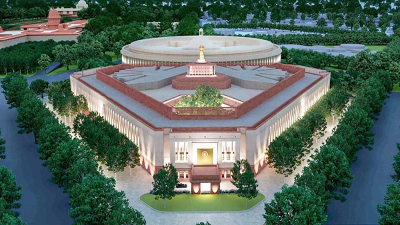
The new Parliament building inaugurated in New Delhi recently is high on symbolism and reflects the aspirations of "new India"
If you have been following the news, you must be aware of the recent inauguration of the new Parliament building in New Delhi. Now let's look at some fascinating features of the new structure.
Prime Minister Narendra Modi dedicated the new Parliament building in New Delhi to the citizens on May 28, 2023. After installing the historic "Sengol" (a sceptre signifying the transfer of power from the British in 1947) in the Lok Sabha chamber, he delivered a speech in which the PM said the new Parliament reflected the aspirations and resolve of the "new India" to work towards achieving greater heights and that it would be a testament to the dawn of Aatmanirbhar Bharat (self-reliant India). He lauded the use of material from different parts of the country in the building to symbolise "Ek Bharat, Shreshtha Bharat".
In the shape of a triangle
The new Parliament building is part of the Central Vista redevelopment project. A beautiful blend of traditional motifs and modern technology, the new building reflects India's diversity in its architecture. Constructed by Tata Projects Ltd, it was completed in about two-and-a-half years at an estimated cost of nearly Rs 1,200 crore. The triangular-shaped four-storeyed building has a built-up area of 64,500 sq. m. The building has three main gates – Gyan Dwar, Shakti Dwar, and Karma Dwar. It also has a Constitution Hall on the ground floor to showcase India's democratic heritage, a lounge for MPs, a library, multiple committee rooms, dining areas, and ample parking space.
State-of-the-art facilities
The new building has been designed keeping in view the future increase in the number of members. The Lok Sabha Chamber has 888 seats and the Rajya Sabha chamber has 384 seats. The LS can accommodate 1,272 members during a joint session of the Houses. The new Parliament building is equipped with state-of-the-art facilities and high-tech gadgets to enable members to perform their functions in a better way. The Houses will be paperless with Wi-Fi enabled tablets provided to members. The new building also has six new committee rooms and 92 rooms for use as offices of Ministers.
The public entrances lead to three galleries – the Sangeet Gallery which exhibits dance, song, and musical traditions of India, the Sthapthya Gallery depicts the architectural heritage of the country, and the Shilp Gallery showcases distinct handicraft traditions of different States.
High on symbolism
The new parliament building is home to nearly 5,000 artwork, including paintings, wall panels, stone sculptures, and metal murals. While the interior in the Lok Sabha has motifs and colours of the national bird peacock (on carpets, ceiling and lattice work of windows), a lotus theme runs through the Rajya Sabha chamber. The "Sengol" in the Lok Sabha symbolises India's freedom, sovereignty, and fair governance. A Foucault's Pendulum hanging from the roof of the Constitution Hall is meant to symbolise "the integration of the idea of India with that of the universe". The national emblem made of bronze sits atop the building.
With carpets from Mirzapur in Uttar Pradesh, bamboo flooring from Tripura and stone carvings from Rajasthan, the new Parliament reflects India's diverse culture. The teakwood used in the building was sourced from Nagpur in Maharashtra, while the red and white sandstone was procured from Sirmathura in Rajasthan. The Kesharia green stone was from Udaipur, and the red granite from Lakha near Ajmer. The steel structure for the false ceilings in the LS and RS chambers was sourced from the Union Territory of Daman and Diu, while the furniture in the new building was crafted in Mumbai.
Besides, the building used manufactured sand or M-sand from Charkhi Dadri in Haryana for preparing concrete mix for the construction. M-sand is considered environment friendly as it is manufactured by crushing large hard stones or granite and not by dredging of river beds.
It is said that the construction of the new Parliament building gave employment to 60,000 workers and a digital gallery dedicated to them forms part of the complex.
Picture Credit : Google




